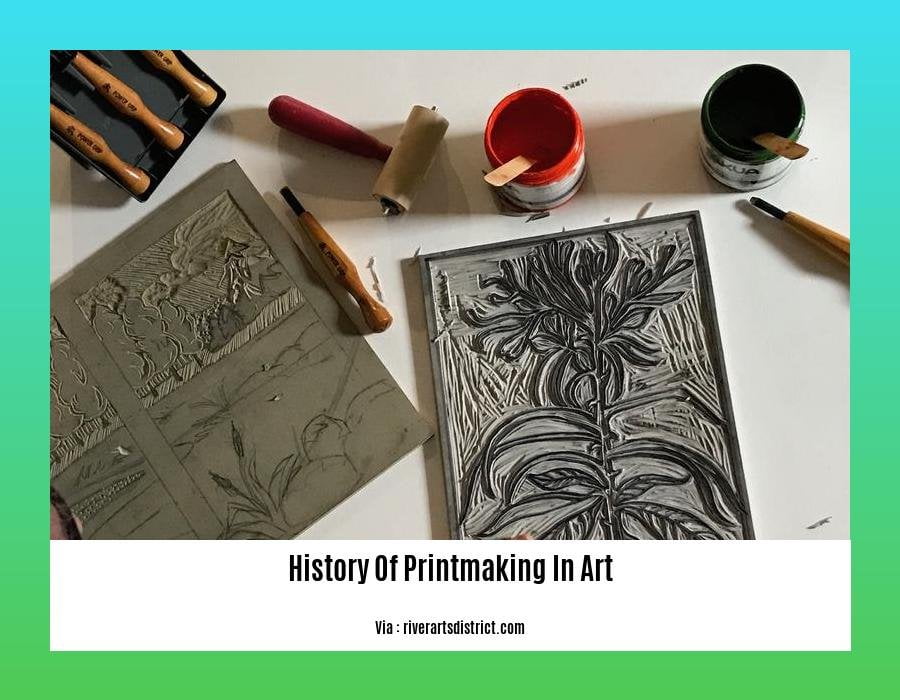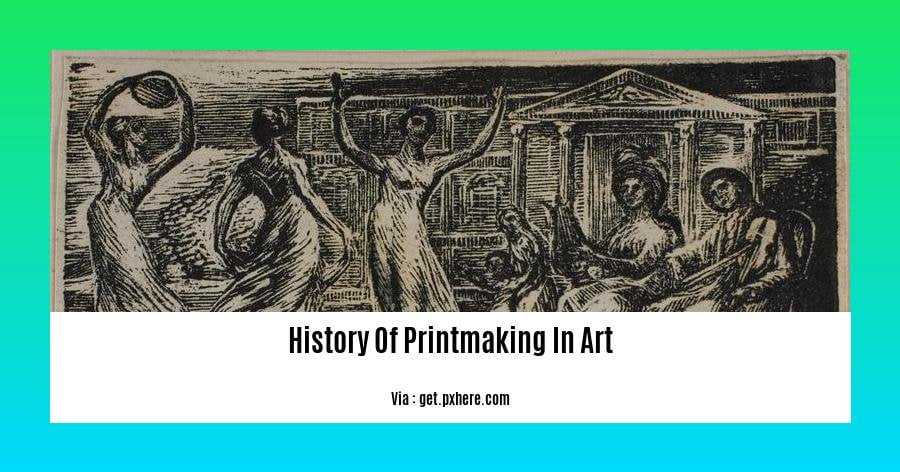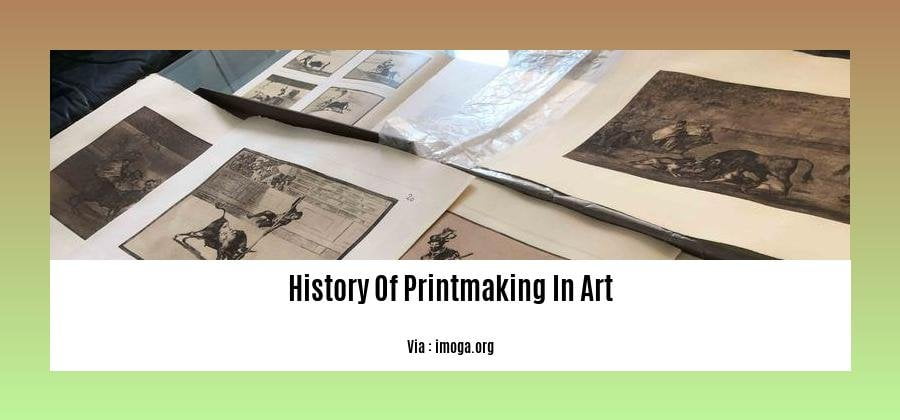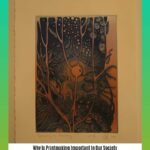Embark on a captivating journey through time as we delve into the fascinating history of printmaking in art: [A Journey Through Time: Exploring the History of Printmaking in Art]. From its ancient origins to its profound impact on artistic expression, discover the evolution of printmaking techniques and the remarkable contributions of printmakers throughout the ages.
Key Takeaways:
- Definition of Printmaking:
- Printmaking is the process of creating images on various materials, such as paper, fabric, or plastic.
- Fine printmaking is considered an original art piece made using different multiplication techniques.
Examples of printmaking techniques include linoleum cuts, Japanese Ukiyo-E prints, etching, lithography, metal graphics, and plaster prints.
History of Printmaking:
- Printmaking origins date back to ancient times, with evidence on prehistoric bones and stone seals in China.
- In Europe, textile printing was known around the 6th century.
- With papermaking’s emergence in the 12th century, paper prints were created, with the first European paper made in 1151.
- Printmaking thrived in Netherlands and Burgundy during the 15th and 16th centuries with engraving and etching techniques.
- The 20th century brought about new techniques and styles, like German Expressionism and viscosity printing.
History Of Printmaking In Art

Imagine the ability to create multiple identical artworks that retain the authenticity of a one-of-a-kind piece. That’s the magic of printmaking, an art form with a rich history spanning centuries. Join us as we venture through time to trace the evolution of printmaking, exploring the techniques, artists, and impact of this captivating art form in the grand tapestry of art.
Ancient Origins: The Genesis of Printmaking
Printmaking’s roots stretch back to the ancient world, where civilizations discovered the art of transferring designs onto various surfaces. Engraved patterns on prehistoric bones and stone seals reveal the early use of this technique.
Papermaking Revolutionizes Printmaking
A major turning point in printmaking occurred with the advent of papermaking in China during the 12th century. Paper, with its smooth, absorbent surface, provided an ideal medium for transferring images, making it a popular choice among artists.
The Rise of European Printmaking
Europe embraced the art of printmaking during the 15th and 16th centuries, particularly in the Netherlands and Burgundy. This period witnessed the emergence of engraving and etching techniques, which significantly expanded the expressive possibilities of printmaking.
The Mastery of Albrecht Dürer
Hailed as one of the greatest printmakers of all time, Albrecht Dürer’s intricate engravings and woodcuts revolutionized the art form. His works, such as the famous “Knight, Death and the Devil” and “Melancholia I,” remain iconic examples of the power and artistry of printmaking.
The Japanese Ukiyo-E Movement: A Realm of Beauty and Tradition
In 18th-century Japan, the Ukiyo-E movement flourished, introducing a new era of printmaking characterized by vibrant colors, delicate lines, and scenes depicting everyday life, landscapes, and theater. Artists like Katsushika Hokusai and Utagawa Hiroshige captivated audiences with their masterful works.
The 20th Century: A Surge of Innovation
The 20th century witnessed a surge of experimentation and innovation in printmaking. German Expressionists like Ernst Ludwig Kirchner and Erich Heckel challenged traditional notions of form and color. Meanwhile, viscosity printing, developed by Stanley William Hayter, opened new avenues for artistic expression.
Contemporary Expressions: Printmaking Today
In contemporary times, printmaking continues to thrive, embracing a diverse range of techniques and styles. From traditional practices like etching and lithography to digital and mixed-media approaches, contemporary printmakers push the boundaries of the medium, creating works that reflect the globalized, interconnected world we live in.
With roots embedded in ancient traditions and a future brimming with possibilities, printmaking in art stands as a testament to the enduring power of creativity and expression, forever etched in the annals of art history.
Looking to explore the history of printmaking prints? Delve into the captivating journey of how these remarkable artworks came to be.
Curious about the origins of printmaking? Discover the fascinating story of its inception by clicking on When Did Printmaking Originate.
Ever wondered if prints of paintings hold any value? Are Prints Of Paintings Worth Anything reveals the intriguing truth behind their worth.
Wondering if original prints hold significant value? Explore the intriguing world of Are Original Prints Valuable, and unveil the factors that determine their worth.
Keen to know why printmaking matters in our society? Why Is Printmaking Important In Our Society showcases its profound impact on culture, creativity, and self-expression.
**Major artists who have worked in the medium: A discussion of the significant artists who have used printmaking to create iconic works of art, from Albrecht Dürer to Andy Warhol**

Key Takeaways:
Andy Warhol: A pioneer of the Pop Art movement, Warhol used silkscreen printing to create iconic works that reflect the consumer culture and celebrity obsessions of his time. His works, including the Campbell’s Soup Cans and the Marilyn Monroe prints, are instantly recognizable and have had a profound impact on the art world.
Albrecht Dürer: A German artist of the Renaissance period, Dürer is considered one of the greatest printmakers of all time. His engravings and woodcuts, such as “Knight, Death and the Devil” and “Melencolia I,” are highly detailed and expressive, showcasing his mastery of the medium.
Francisco Goya: A Spanish artist of the 18th and 19th centuries, Goya is known for his powerful and thought-provoking prints. His series, “The Disasters of War,” portrays the horrors and brutality of the Napoleonic Wars, while his “Caprichos” satirizes the social and political issues of his time.
Edvard Munch: A Norwegian artist of the late 19th and early 20th centuries, Munch is best known for his iconic print, “The Scream.” This work, with its haunting and expressive depiction of a figure in existential anguish, has become a symbol of the anxieties and uncertainties of the modern world.
Pablo Picasso: A Spanish artist of the 20th century, Picasso is considered one of the most influential artists of all time. He experimented with various printmaking techniques, including etching, lithography, and linocut, creating works that reflect his diverse artistic styles and periods.
These artists, among many others, have made significant contributions to the art of printmaking, pushing the boundaries of the medium and creating works that have left an indelible mark on the history of art.
Source:
– Andy Warhol Paintings, Prints+, Bio, Ideas | TheArtStory
– Huckleberry Fine Art – Exploring The Meaning Behind Warhol’s …
Impact of Printmaking on the Development of Art: The Role of Printmaking in the Dissemination of Images and Ideas, and its Influence on the Evolution of Artistic Styles and Movements.
Over time, printmaking has reshaped artistic expression and shaped the art world as we know it. Its impact extends beyond merely being a technique; it’s a tale of democratization, innovation, and interconnectedness.
Printmaking: The Game-Changer
In printmaking’s earliest days, artists discovered that transferring images onto paper could make masterpieces accessible to all. It was a revolutionary act, a democratization of art that broke down barriers of class and distance. Printmaking sparked a global exchange of ideas and images, influencing artistic styles worldwide like a whisper carried by the wind.
Printmaking’s Evolution
As printmaking evolved, it wasn’t just a new medium; it marked an era of innovation that spread like wildfire. Woodblocks, engravings, lithographs—each technique brought a unique flavor to the art world. Artists relished the newfound freedom to experiment with colors, shapes, and textures, pushing the boundaries of artistic expression.
Printmaking’s Mark on Art History
Printmaking has left an undeniable mark on art history. From Albrecht Dürer’s exquisite engravings to Japanese Ukiyo-E masters’ vivid colors and everyday scenes, printmaking’s influence is vast and undeniable. Artists like Goya, Munch, and Warhol have all drawn inspiration from printmaking’s rich tapestry of techniques and aesthetics, shaping the course of art history.
Key Takeaways:
Printmaking democratized art, making masterpieces accessible to all, irrespective of class or location.
It facilitated a global exchange of ideas and images, fostering a fertile ground for artistic innovation.
The evolution of printmaking techniques, from woodblocks to lithographs, expanded the horizons of artistic expression.
Printmaking has played a pivotal role in shaping the course of art history, inspiring artists across various eras.
Contemporary printmaking embraces diverse techniques and styles, blending traditional methods with digital and mixed-media approaches.
Citation:
Printmaking in popular culture: The use of printmaking techniques in various forms of popular culture, including posters, comics, and banknotes
Have you ever noticed the eye-catching posters that adorn city streets or the vibrant comic books on the shelves? These works of art often owe their existence to printmaking, a process that has revolutionized the way we create and share visual content. Dive into the world of printmaking and delve into its significant role in popular culture.
A Creative Journey Through Popular Culture
Printmaking isn’t just confined to the walls of art galleries. It has seeped into the very fabric of everyday life, bringing art to the masses like never before. Let’s take a closer look at some of the most prominent examples:
Posters: Images That Speak Volumes
Posters have become ubiquitous in our urban landscapes, capturing our attention with their bold designs and compelling messages. From movie promotions to social causes, printmaking has democratized the art of poster creation, making it accessible to a wide range of audiences.
Comics: Storytelling at Your Fingertips
The world of comics would be incomplete without the magic of printmaking. Each panel, each character, and each captivating storyline is brought to life through intricate printing techniques. Comics wouldn’t be the same without the vivid colors and expressive lines made possible by printmaking.
Banknotes: A Blend of Security and Aesthetics
Printmaking isn’t just about capturing the imagination; it also plays a crucial role in safeguarding our financial system. Banknotes, with their intricate designs and security features, rely on advanced printmaking techniques to prevent counterfeiting and maintain trust in our currency.
Key Takeaways:
- Printmaking techniques have brought art to the masses through posters, making it accessible and impactful.
- Comics rely heavily on printmaking for their captivating visuals and expressive storytelling.
- Banknotes utilize printmaking to ensure security and maintain trust in our financial system.
Citation:
The Art of Printmaking in Popular Culture
The History and Impact of Printmaking
FAQ
Q1: How did printmaking democratize access to art?
A1: Printmaking techniques allowed for the reproduction of artworks, making them more affordable and accessible to a wider audience, breaking down barriers of class and geography.
Q2: Which printmaking technique is known for its bold and graphic prints?
A2: Linoleum cut is a printmaking technique that involves carving a design into a linoleum block, inking the raised areas, and then pressing it onto a surface, resulting in bold and graphic prints.
Q3: What role did printmaking play in the dissemination of ideas during the Protestant Reformation?
A3: Woodcut, a printmaking technique, was commonly used to print religious images, playing a significant role in the spread of ideas during the Protestant Reformation, facilitating the dissemination of religious messages and imagery.
Q4: How did the development of lithography impact the printing industry?
A4: Lithography revolutionized the printing industry, especially in the areas of poster printing, sheet music, and advertising. Its ability to produce high-quality color prints at a relatively low cost made it widely adopted for commercial printing purposes.
Q5: How did printmaking help preserve and disseminate artworks more effectively?
A5: Printmaking allowed artists to produce multiple copies of the same image, enabling them to preserve and disseminate their artworks more effectively. This facilitated the wider distribution and appreciation of artworks, contributing to the growth and development of the art world.
- China II Review: Delicious Food & Speedy Service - April 17, 2025
- Understand Virginia’s Flag: History & Debate - April 17, 2025
- Explore Long Island’s Map: Unique Regions & Insights - April 17, 2025
















